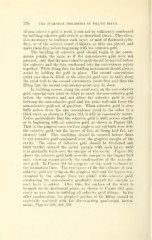Page 576 - My FlipBook
P. 576
276 THE TECHNICAL, PROCEDURES IN FILLING TEETH.
of non-eohesive gold is used, it can not be sufficiently condensed
by building cohesive gold over it, as described above. Therefore,
it is necessary to condense each layer, or mat, of flattened cylin-
ders, or of the several round cylinders, as they are placed, and
make them firm before beginning with the cohesive gold.
The building of cohesive gold should begin in the conve-
nience points, the same as if the non-cohesive gold were not
present ; only that the non-cohesive gold should be carried before
the cohesive and the two condensed into the convenience points
together. While doing this, the holding instrument should always
assist by holding the gold in place. The second convenience
point may then be filled, or the cohesive gold may be built along
the axial wall to the second convenience point first and then the
filling into the second convenience point may be done.
In building across, along the axial wall, on the non-cohesive
gold, especial care must be taken to carry the non-cohesive gold
before the cohesive and not allow the cohesive gold to slip
between the non-eohesive gold and the axial wall and force the
non-cohesive gold out of position. When cohesive gold is once
built across from the one convenience point to the other in a
thick mass, as shown in Figure 361, it will be reasonably secure.
Notice particularly that the cohesive gold is built across exactly
as in beginning with all cohesive gold, as shown in Figure 345.
That is, the gingival cavo-surface angle is not yet built over with
the cohesive gold, but the layers of foil, all being laid flat, are
securely held. This condition should be secured before there
is any cohesive gold condensed over the gingival margin of the
cavity. The mass of cohesive gold should be thickened and
built farther toward the cavity margin with each layer, until
it is gradually built over the margin of the cavity. Figure 362
shows the cohesive gold built over the margin in the lingual half
only, showing comparatively the condensation of the non-cohe-
sive gold. In Figure 364 the progress of this work is shown by
the lamination lines. The two layers of the flat cylinder of non-
cohesive gold are lying on the gingival wall and the layers rep-
resented by the oblique lines are added with cohesive gold,
condensing the non-cohesive gradually toward the margin as
each layer is added. After this, the surface of the work is
brought to the horizontal plane, as shown in Figure 363, pre-
cisely as was done in building all cohesive gold fillings. In the
after condensation, the gingival portion of the filling should be
espeeiallv malleted with the direct-acting quadrangle instru-
ments. Figures 328, 329, 330.


